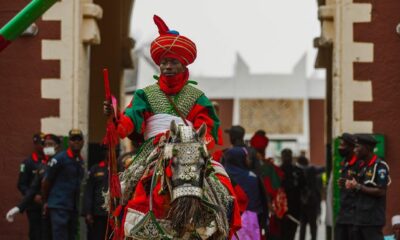Features
Olawunmi’s Recount of Her Trip to Ile-Ife Shows Rich Cultural Heritage of Yoruba People & We’re Here For It
 Some things leave lasting effects and memories; like first love, first kiss or the first time one gets laid. I have decided to explore and maximise the adventurous part of me – not every day politics and trying to make money.
Some things leave lasting effects and memories; like first love, first kiss or the first time one gets laid. I have decided to explore and maximise the adventurous part of me – not every day politics and trying to make money.
Naturally, when I need to cool off, I just travel… preferably by road, to enjoy the serenity of nature and the beautiful landscapes. When I go by air I always like the window seat because it enables me to get a good view of the cloud, (firmament, as the Bible puts it) and I appreciate the mighty works of God while I enjoy the sight of a city that once seemed big. Everything reduces to tiny houses and settlements until it eventually disappears as we ascend and that’s all. But then there’s a lot to our country, Nigeria, than we give her credit for. Apart from the oil wells and minerals, there’s so much she’s endowed with especially in the areas of tourism and culture.

Life is a journey and your voyage through it is as rich as the people you travel with. It was my first time meeting the people on this tour, and it felt like we’d known each other forever. We laughed and joked for the duration of the 4-hour trip from Lagos to Osun. Even the couple that joined us at Ibadan caught the fever as they stepped into the bus. The conversations were intelligent and life experiences were shared. I learnt a lot and it was a relief to know that we still have young people with good values and intellect.

My visit to Osun state was totally breathtaking. The first stop was the Olumirin waterfalls, and it involved a bit of hiking – 300 steps. The falls were about 40 meters high. I was told there are 7 levels, but the fun was at 3rd level so there was no need to climb further
There were obviously old but very beautiful canvases hung on both sides of the rocks that served as passages to the waterfalls. The air was so clean and fresh. The sight and the speed of the water as it hit the rocks was totally amazingly beau-ti-ful.
 After the waterfalls, our next stop was the Ooni of Ife’s palace. The first image you see there is that of Oduduwa – who I was told descended from heaven to Ile-Ife with a hen on one hand, and a chain on the other.
After the waterfalls, our next stop was the Ooni of Ife’s palace. The first image you see there is that of Oduduwa – who I was told descended from heaven to Ile-Ife with a hen on one hand, and a chain on the other.
Asides the luxury cars which included a Rolls-Royce, the bronze gates with gold plated embellishments and antique architecture, the palace is home to a lot of history and tradition. I saw the courts where judgement used to be passed in those days.
There were monuments in the hall where the chiefs met. A particular door, which had 2 swords above it (with one missing), told the story of a king whose slaves fell in love and had a child. When it was reported to the king, he told them to let the slaves be and said “the way kings are born is the same way slaves are born and they should be taken care of” . However, the queen at that time, didn’t want her female slave enjoying the same benefits, so she ordered them to feed the slave just vegetables. The slave was so hurt that she was being maltreated that she stripped naked and in tears cursed the queen.
The queen then got pregnant several times, but none of her children survived (what the Yorubas call abiku). After consulting the oracle it was revealed that it was the slave’s curse that was the cause of the deaths. The only restitution was for the queen to eat the same food she fed the slave with whenever she gave birth, so that her children could survive.
Till date that tradition is being practiced; new mothers are fed with plain vegetables with no oil and salt for the first 7 days after child birth in Osun State.
At the front porch, there are 2 tombs of past kings of Ile-ife, one on the right and the other on the left.

There was the brief visit to the house of wisdom – where people pray. It is believed that every prayer is answered there. It is painted white, with clay-tiled floor and you are ordered to pull off your shoes before stepping into the main place. There is a rectangle-shaped hole in the middle, with various heaps of salt and palm oil coverings. No cameras are allowed there. You are given just a minute to say your request quietly as one of the palace chiefs holds a locally made bell to signal the beginning and the of your prayer after which you are to drop some money on the ground. I wonder if the money disappears or it gets spent and by who?
It’s also said that if one was suspected of stealing and taken there. The person will be required to cross the rectangular hole 7 times, and if found guilty, the perpetrator will die on the 7th day.
There’s a part that’s square shaped and designed with different patterns where it is said that the only female king that once ruled had men crouched on all their fours and she mounted them like horses to her destination, since there were no cars back then. Because of her behaviour, no woman has ever been allowed to become king since then.
Behind the hall was the tomb/house where the last Ooni was buried which is well decorated with pictorial evidence of his achievements. It is a marble tomb engraved with his name and title. There are royal chairs, and it is fully air conditioned; a Persian rug runs from wall to wall. It’s just like he is still living there.
Outside, to the right, there is a big garden with clay tiled pathway that paved way to a white well with white bowls and several cups meticulously arranged on the paths that leads to the well and around it. It is said that one of the previous kings had a wife who was barren for years and begged her husband to marry a second wife but he refused because he loved her. She then liaised with her friend to marry her husband in order for him to have children. When her friend started having children for her husband, she became rude and insulted the queen. It reminded me of the story of Abraham and Sarah in the Bible, just that this ended differently. The queen was so disappointed and hurt that she went to the garden and cried so much that she started to enter the ground and her tears became a well of water.
When the king got back from his trip, he started to look for the queen all over but all to no avail. Then one of the servants noticed the well that wasn’t there before, and brought it to the king’s notice. The ifa oracle was consulted and it was revealed that it was the queen who was too pained to live that she preferred to be a well, and wished that every woman with similar issues would drink from the well and have her heart’s desire. Also anyone that became the crowned king must be married to her and that happens by the king crossing over the well, which signifies a sexual intercourse. That tradition is still being practiced till date.

Next was the visit to Queen Moremi’s statue which is the third tallest statue in Africa. Moremi was a female warrior who was married to the king of Ile-ife. When a particular war broke out with the people of the forest who were capturing most of her people, she decided to end the war by giving up herself to be captured by her enemies to learn their secret. She was the definition of beauty with brains and prowess.

The king of the people that captured her saw her and decided to make her his wife and she agreed, on the condition that he showed her the secret of his power and why they had ghosts fighting for them. The king agreed, and each time he wanted to have sex with her she would ask him, but he kept telling her lies that the ghosts were just humans in white cloths (according to our tour guide – men will promise heaven and earth just to lure a woman to have sex with them. Anyway that’s a write up for another day). She refused him sex until he eventually revealed their secret. Then she escaped and returned to her people and told them their secret which was used to defeat their enemies in battle. She returned back to her first husband who gladly re-instated her back, but had to give up her first son Olurogbo for sacrifice to the gods, as a result of the pledge she made to the gods, if they ensured that she returned safely. Her bravery is still being celebrated across Yoruba land till date.
Finally, we visited Oranmiyan’s groove, which had a rectangular shaped pavement with Oramiyan’s stick. It’s very long and has a white cloth tied around it with bullet holes in a straight line at the top and under the white cloth.

The custodian of the groove is an old man that wanted us to sit around like they did in tales by moonlight. He told the story of Oramiyan – a great warrior in his days. He was getting old he decided to make himself invincible and left his stick which is called opa, in Yoruba as means for his wife to reach him. But, he warned her not to reach out to him except there was war and he was needed to fight. One day his wife decided to try if she could actually call him out of the stick, so she summoned him and went out. He appeared thinking there was war and when he saw many young men in his house he started to cut their heads with his sword and killed them all.

He was proceeding to the village square when his wife saw him and her sons in the pool of their blood in their compound. She started crying that he had killed their children – it apparently took him some time to come out for them to have missed each other in the first place #justmythoughts. On realizing that, he raised them back to life by taking a piece of cloth from his pocket and touched all of them. It was at that point that he officially retired to avoid making the same mistake twice I guess.






















